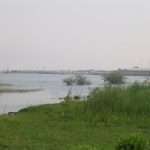Hippos and railway trains
BBC television’s Hippos: Africa’s River Giants recalls an unlikely combination of memories: an encounter with hippos in the wild with questions about a historic railway. Taken to a lakeside restaurant in the Burundian capital of Bujumbura meant eating to the sound of argumentative hippos further up the shore. At the other end of the beach, it seemed odd to see docks; where on Lake Tanganyika would one sail with a cargo ship? What place could combine one of the strangest of animals with the most mundane activity of transporting freight? What other cities lay on the lake? What trade might there be between them?
“Where is the freight from?” I asked my companion, who had assured me that the hippos were not a cause for concern.
“The sea,” he said. He obviously noted an expression of puzzlement; even with very limited geographical knowledge, it is easy to be aware that the sea is a long way from Burundi. “There is a railway in Tanzania, it comes from Dar-Es-Salaam.”
What might a rail journey across the vastness of Tanzania be like? Once I had travelled across the country by road, from the capital to the shores of Lake Malawi. The journey had taken two days and had demanded hours of travel in darkness, something difficult on unsurfaced roads. Was the railway a recent innovation? Hardly, it would have demanded huge investment. Who had been responsible for a line that provided an overseas connection to one of the poorest countries in the world? In a region where tarmac roads were frequently beyond budgets, a railway line would be the stuff of dreams.
A copy of the “Railway Year Book’ for 1923 offered a story almost as unlikely as the life of hippos. The book provides brief information on railways around the world, it includes a section explaining how cargo ships come to be found in the habitat of hippos:
TANGANYIKA TERRITORY RAILWAYS
(East African Rys., lately German)
Headquarters: Tanga
Chief Officers: General Manager, G.A.P. Maxwell, D.S.O., M.C., R.E., Dare-Es-Salaam; Chief Engineer, Major R.M. Raven; Traffic Managers, Major C.R. Webb, M.C., R.E.; Chief Mechanical Engineer, K.C. Strahan; Chief Accountant, H. Noel Davies, O.B.E.; Chief Storekeeper, N. Dorkin.
General Particulars: Central Ry., Dar-Es-Salaam to Kombe, 1,244 km.; Tanga Railway, Tanga to Moshi, 352 km.; Voi Military (Voi, Uganda Ry to Kahe, Tanga Ry.), 151 km. Sigi Railway, 23 km.; Lindl Railway, 85 miles. The Central Railway, in conjunction with steam services on Lake Tanganyika, provides a direct route to the Belgian Congo. The Central and Tanga Rys. were taken over on the occupation of German East Africa by the British. The Voi Military Ry. connects the latter with the Uganda Ry.
Statistics: Mileage – metre gauge, 1747 km.; 75 cm. gauge, 23 km.; 60 cm. gauge, 85 miles. No. of locos, 80; coaching vehicles, 92; wagons, 712.
The Central Railway, in conjunction with steamboat services, had provided a direct route to the Belgian Congo, a territory that became the Democratic Republic of Congo (a misnomer, if there ever was one), Rwanda and Burundi. A century later, trains still carry goods from Dar-Es-Salaam on the Indian Ocean to the home waters of hippos.


Both Rwanda and Burundi along with Tanzania were the German East African colony. And the railways were built then.
Interestingly enough the colony held off the British all through the First War. They kept a lot of the imperial armed force on Africa when they could be used in Europe.
Extraordinary as it may seem, the German gunboat that was the inspiration for the film the African Queen is still in service on Lake Tanganyika!
https://en.wikipedia.org/wiki/MV_Liemba